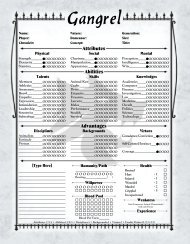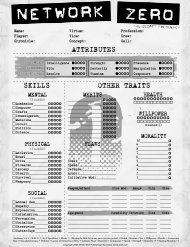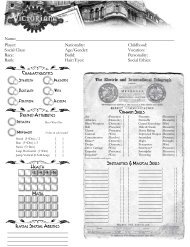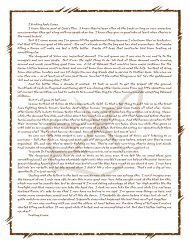World of Darkness: Portland
World of Darkness: Portland
World of Darkness: Portland
You also want an ePaper? Increase the reach of your titles
YUMPU automatically turns print PDFs into web optimized ePapers that Google loves.
10<br />
The history <strong>of</strong> <strong>Portland</strong> is rich and diverse. Lewis<br />
and Clark had traveled across the country to find the<br />
Pacific Ocean, and noted what beauty Oregon beheld.<br />
The Oregon Trail had already begun, with many seeking<br />
the natural resources and wide, uninhabited spaces the<br />
Territory was sure to provide. But it wasn’t until 1843,<br />
when William Overton and Asa Lovejoy beached their<br />
canoe on the bank <strong>of</strong> the Willamette River. Overcome<br />
by the beauty <strong>of</strong> the area, Overton saw great potential<br />
for this mountain-ringed, timber-rich land. His only<br />
problem was that he lacked the 25 cents needed to file<br />
a land claim. So, he struck a bargain with Lovejoy: In<br />
return for a quarter, Overton would share his claim to<br />
the 640-acre site known as “The Clearing.”<br />
The sections in italic type indicate historical<br />
information inserted for the <strong>World</strong> <strong>of</strong> <strong>Darkness</strong><br />
1843-1900<br />
<strong>Portland</strong> was very nearly Boston. Soon tired <strong>of</strong><br />
clearing trees and laying down road foundations,<br />
Overton moved on to other interests. He sold his share<br />
<strong>of</strong> the land to Francis W. Pettygrove. Now partners,<br />
Lovejoy and Pettygrove could not settle on a name for<br />
their fledgling city. Lovejoy wanted to name it after<br />
his home town <strong>of</strong> Boston, Massachusetts; Pettygrove<br />
was just as adamant about his own town, <strong>Portland</strong>,<br />
Maine. Unable to reach an agreement, they decided<br />
to settle the matter by tossing the coin now known as<br />
the “<strong>Portland</strong> Penny.” Pettygrove won two out <strong>of</strong> three<br />
tosses.<br />
Lovejoy and Pettygrove were confident that<br />
<strong>Portland</strong>, with its deep water and abundant natural<br />
resources, would one day become a popular and<br />
prosperous port. They did not suspect, however, how<br />
quickly it would grow in popularity, and for what<br />
activities. <strong>Portland</strong> developed a dark history beginning<br />
in the late 1800s. Joseph “Bunco” Kelly was a hotelier<br />
notorious for kidnapping young men and selling<br />
them to ship captains. Many bar owners and hotel<br />
operators relied on this shanghai trade to supplement<br />
their businesses, and Kelly was one <strong>of</strong> the best. Paid<br />
by unscrupulous captains to intoxicate potential crew<br />
members, Kelly would deliver his drunken quarry to<br />
waiting ships. The unfortunate men would wake up<br />
the next day, stranded at sea and forced to work for<br />
indefinite periods <strong>of</strong> time.<br />
Kelly <strong>of</strong>ten bragged that he could gather<br />
a full crew in less than 12 hours. Inevitably a ship<br />
captain would challenge him. One evening, in his<br />
quest to fulfill a boast, Kelly ran across a group who<br />
had stumbled upon the open cellar <strong>of</strong> a mortuary.<br />
Chapter 1-History<br />
City History<br />
Thinking the cellar was a part <strong>of</strong> the Snug Harbor<br />
Pub, the men had each consumed cups <strong>of</strong> embalming<br />
fluid, which they had mistaken for liquor. When Kelly<br />
found them, several had died and others were dying.<br />
Claiming the dead were merely unconscious from too<br />
much drink, Kelly sold all 22 to a captain whose ship<br />
sailed before the truth was discovered. It was said that<br />
even after the captain discarded the bodies, their ghosts could<br />
be seen manning the ships to mock the living crew. The ship’s<br />
cargo always rotted, the wind never caught in the sails, and<br />
soon the captain was ruined. He sold the boat for scrap and<br />
retired on the <strong>of</strong> the islands in Seattle’s Puget Sound. Some<br />
say the ghost <strong>of</strong> the boat remains with the betrayed men to<br />
guide it.<br />
“Sweet Mary,” the proprietor <strong>of</strong> a brothel, is<br />
another interesting figure in <strong>Portland</strong>’s history <strong>of</strong><br />
the late 1800s. In order to elude taxes and city laws,<br />
she operated her bordello on a barge that ran up<br />
and down the Wilamette River. Technically, she was<br />
outside everyone’s jurisdiction. Police were doubly<br />
concerned because many <strong>of</strong> her clients would turn up missing,<br />
or would refuse to leave the brothel; Sweet Mary, a Daeva,<br />
was building up a small army <strong>of</strong> Ghouls.<br />
1900-1950<br />
Most <strong>of</strong> this type <strong>of</strong> behavior was quelled by the<br />
turn <strong>of</strong> the century, (at least to mortal eyes). Secure jobs<br />
in lumber mills and wealth from providing goods to the<br />
California Gold Rush helped stabilize the economy,<br />
giving the city’s population more time to regulate the<br />
seedy activities <strong>of</strong> its busy waterfront. The local vampires<br />
realized that <strong>Portland</strong> was changing, and began more discreet<br />
operations.<br />
Personifying this shift in attitude was Simon<br />
Benson, a teetotalling lumber baron and philanthropist.<br />
While walking through his mill one day, Benson<br />
noticed the smell <strong>of</strong> alcohol on his workers’ breath.<br />
When Benson asked these men why they drank in<br />
the middle <strong>of</strong> the day, they replied there was no<br />
fresh drinking water to be found downtown. Upon<br />
hearing this, Benson proceeded to commissioned 20<br />
elegant freshwater drinking fountains, now known as<br />
the Benson Bubblers. Beer consumption in the city<br />
reportedly decreased 25 percent after the fountains<br />
were installed.<br />
Simon Benson’s water fountains still bubble<br />
invitingly on <strong>Portland</strong>’s downtown streets. And around<br />
the fountains has grown a city <strong>of</strong> parks, outdoor<br />
artwork, c<strong>of</strong>fee carts, microbreweries, bridges and<br />
bookstores. <strong>Portland</strong>’s new attitude was to be a people<br />
town, a pedestrian-friendly city. Blocks were made to



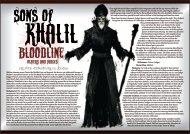
![Interactive Werewolf The Forsaken 4 Page Sheet Version 2[B&W]](https://img.yumpu.com/18249805/1/190x247/interactive-werewolf-the-forsaken-4-page-sheet-version-2bw.jpg?quality=85)

